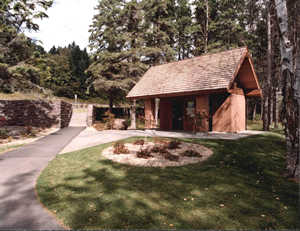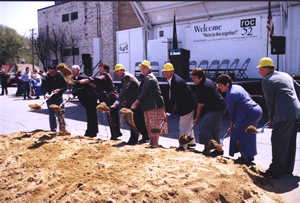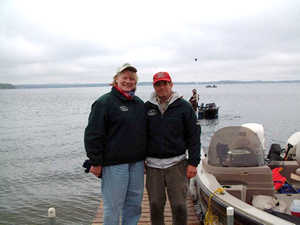 |
 |
|
 |
Proposal would keep state rest areas open through June 2004 |
 |
 |
 |
The Cut Face Creek Rest Area, located five miles west of Grand Marais
on Hwy 61, is one of the state's rest areas slated to close if Lt. Gov./Commissioner
Carol Molnau's proposal is not adopted by the Legislature this year.
Photo by Neil Kveberg
|
Lt. Gov./Commissioner Carol Molnau presented a proposal to the Legislature
on May 13 that would keep all of Minnesotaís 77 roadside rest areas open through
June 2004.
Earlier this year, as part of the administrationís plan to increase funding
for transportation projects, Mn/DOT had proposed changes in rest area operations
that would have resulted in some closures.
Under Molnauís plan, Mn/DOT would tap $2 million in unspent appropriations
from the FY 2002-03 biennium to supplement rest area funding in FY 2004. The
plan would allow the department to maintain its FY 2004-05 commitment to providing
$84 million in internal budget reallocations to support the Pawlenty-Molnau
administrationís $1.2 billion transportation financing plan.
Follow these links to read the complete rest
area news release or to view other recent
Mn/DOT news releases.
|
back

|
 |
Initiative to accelerate construction process |
 |
 |
Why is there so much talk these days about building more roads?
Could it be because congestion doubled from 1990 to 1997, and Minnesota ranks
as the 15th most congested state? Or could it be because there are more than
2.96 million licensed drivers on Minnesota roadways traveling 53.3 billion vehicle
miles each year?
Whatever the cause, there remains a growing demand on the stateís transportation
infrastructure, and the public wants Mn/DOT to respond by delivering construction
projects faster and more efficiently.
The newly established Innovative Construction Initiative under the Engineering
Services Division will serve as a key instrument in Mn/DOTís toolbox to help
accelerate the construction process. This initiative will explore new methods
to deliver construction projects faster, manage design-build policies and procedures,
oversee design-build RFPís and contracting, use innovative contract training
and staff development, monitor design-build project selection and packaging,
and develop an industry liaison on innovative contracting projects.
"The primary mode of transportation in Minnesota is highways. Itís important
that we redirect our focus on providing safer and more efficient roads for the
traveling public," said Lt. Gov./Commissioner Carol Molnau.
The ICI teamóGary Thompson (ICI director), Mary Prescott (finance and business
management), Paul Huston (program management), David Miller (district/Central
Office coordination) and Susan Cahill (administration)óaccepted the challenge
to find new ways to meet future transportation needs.
"We are a small group that must make huge strides, but we canít do it
alone," said Thompson. "We need input and support from all the key
players in the construction process, internally and externally, to make this
initiative a success."
The team is evaluating each step in the current construction process and identifying
areas to improve inefficiencies and areas to expand best practices and processes.
"We are in a new world which is rapidly changing; we, too, must change
in transportation," said Molnau. "We must develop and initiate new
ways of delivering construction projects faster, and this initiative will further
our efforts."
For more information about the Innovative Construction Initiative, contact
Thompson at 651/284-3502 or via GroupWise.
By Daneeka Marshall-Oquendo
|
back

|
 |
Videoconference sessions offered to help employees handle career transitions |
 |
 |
Human Resources staff will present a series of information sessions in May
and June via videoconference to help employees affected by layoff or bumping
move through a career transition.
The sessions will be offered in videoconference rooms statewide from noon to
1 p.m., and will cover such topics as career planning, networking and using
the Internet for job hunting. Employees are invited to attend one or all of
the sessions and to bring their lunch. Registration for the sessions is required.
Click here for
more information.
Other news related to the layoff and bumping process includes:
Employees have until June 10 to declare their intent to either accept their
layoff or exercise their bumping options, according to Rich Peterson, acting
director, Office of Human Resource Operations. If affected employees already
are certain about what they will do, they are encouraged to declare their
intent earlier than June 10, in writing and to the Human Resources contact
indicated in their layoff letter, Peterson said. This will help the decision
process for other affected employees.
During the week of May 5, 365 employees attended one of nine layoff information
sessions offered at the Arden Hills Training Center. Employees heard brief
presentations on the layoff process, benefits and insurance, unemployment
insurance, the dislocated worker program, workforce centers, Minnesota State
Retirement System, deferred compensation and the state employee assistance
program. Employees also had the opportunity to meet individually with presenters,
their HR contact and representatives from the unions.
Employees can get additional information by checking out the departmentís
layoff Web site. The site has updated
information, answers to frequently asked questions, Human Resources contacts
and links to employment resources.
|
back

|
 |
ROC on: Rebuilding of Hwy 52 in Rochester begins |
 |
 |
 |
Tossing ceremonial shovelsful of dirt at the ROC 52 ground-breaking
are (from left) Matt Flynn, chair, Olmsted County Board; Herb Morgan,
ZRC project manager, State Sen. Sheila Kiscaden; U. S. Rep. Gil Gutknecht;
Lt. Gov. Carol Molnau; John Wade, Rochester C of C; Nelrae Succio, Rochester
District engineer; State Rep. Carla Nelson, and Chuck Canfield, former
Rochester mayor. Photo by Brian Jergenson
|
Mn/DOT officially launched its largest one-time highway reconstruction project,
rebuilding Hwy 52 in Rochester, with appropriate fanfare in Rochester on May
3.
Dignitaries, including U.S. Rep. Gil Gutknecht, Lt. Gov./Commissioner Carol
Molnau, area elected officials and Nelrae Succio, Rochester/District 6 engineer,
spoke at the groundbreaking ceremonies held in the Miracle Mile Shopping Center
adjacent to the highway.
In addition to the speeches, children clambered over construction equipment
and residents met with state legislators and Mn/DOT staff to discuss the effects
of the project on the future of the city and the region.
The $232 million project, known as ROC 52, employs the design-build, best-value
process. Using design-build will enable the reconstruction of Hwy 52 through
the heart of Rochester to be completed in about three years instead of the 11
years that the standard design-bid-build process would take.
In addition, the design-build benefits Mn/DOT and taxpayers by awarding the
entire contract at the start of the project, saving millions of dollars related
to administrative costs, inflation and acquiring needed right of way several
years ahead of time. A consortium of contractors known as Zumbro River Constructors
will perform the projectís tasks.
Construction this year includes rebuilding frontage roads, installing noise
walls, constructing temporary bridges and temporary widening to prepare for
mainline construction in 2004.
When completed, the rebuilt highway will include six lanes from 75th Street
NW to Hwy 63, four reconstructed interchanges, two new overpasses and new or
rebuilt frontage roads. Rebuilding the roadway in Rochester also improves Hwy
52ís capacity to serve as the major corridor between the city and the Twin Cities
metro area.
The short construction period also helps minimize disruption to commuters,
businesses in the corridor and other users. Since the projectís inception, Mn/DOT,
the city of Rochester, Olmsted County, contractors and affected businesses have
used a "weíre in this together" theme to keep communication open and
to minimize disruption to businesses and other destinations in the area, said
Brian Jergenson, district public affairs coordinator.
Molnau said the project speaks well for using design-build more widely in the
future.
"On ROC 52, weíve saved an estimated $30 million over the life of the
contract by avoiding costs related to inflation and having to pay more to acquire
right of way several years in the future. For these reasons and more, Mn/DOT
plans to use the design-build, best-value approach at other locations around
the state to accelerate construction of desperately needed highway and bridge
projects without raising taxes," she said.
By Craig Wilkins
|
back

|
 |
Mn/DOT partners with community to replace trees, shrubs removed during Hwy 27
project |
 |
 |
 |
Paul Walvatne, Environmental Services (at left) leads volunteers as
they loosen soil to plant shrubs along Hwy 27 near Alexandria. Photo
by Dan Kuhn
|
Led by Mn/DOT forester Paul Walvatne and Dan Kuhn, Detroit Lakes/District 4
operations engineer, 30 volunteers put their backs into planting trees along
Hwy 27 to replace vegetation removed along a one-mile section of the roadway
near Alexandria during a highway improvement project.
The construction project required removing trees to widen shoulders and install
turn lanes on part of the nine-mile reconstruction of the highway near Lake
Geneva and Lake Victoria. The replanted area lies between the highway and the
Central Lakes Bike Trail.
The volunteers included area residents and community groups such as the Central
Lakes Bike Club, said Dan Kuhn, operations engineer at Morris.
To restore the areaís vegetation, volunteer workers planted more than 1,100
native trees including burr oak, green ash and basswood and shrubs such as chokecherry,
sumac and silver buffaloberry.
Al Leiffort, Douglas Countyís park director, joined Walvatne and Kuhn to coordinate
the project. Mn/DOT purchased the trees and shrubs and planned the project;
the county recruited volunteers and provided traffic control and tools and other
equipment for the job.
"We had a relatively small but hard-working crew," Kuhn said. "We
were able to get more than 1,100 plants in the ground between 8 a.m. and 12:30
p.m."
By Craig Wilkins
|
back

|
 |
Final project underway to widen I-94/I-694 in Twin Cities |
 |
 |
 |
Concrete paving equipment stands ready for action rebuilding and widening
the westbound lanes of Interstate I-94/I-694 at County Road 81 in Brooklyn
Park. Reinforcing bar on the right is bent and tied into place before
a slip-form concrete paving machine forms a new median barrier separating
the east and westbound lanes of the interstate. Photo by Kent Barnard
|
Motorists traveling along the I-94/I-694 corridor between the Mississippi River
and its junction with I-494 have grown accustomed to road and bridge construction
through the cities of Brooklyn Park, Brooklyn Center and Maple Grove since the
2001 construction season.
And even though they still may not be happy with the congestion and resulting
delays, most of them would have to admit the end justify the means.
Work began during the 2001 construction season to add a third lane and upgrade
the interstate corridor with new bridges, shoulders, noise walls, new signing
and improved drainage.
The sixth and final project began in early May to widen nearly two miles of
I-94/I-694 between Highway 169 and the I-494 junction in Maple Grove. As with
the other five projects, motorists are encountering non-rush hour lane and shoulder
closures along with lane shifts.
The good news for motorists is that even though more construction began, two
of the projects should be completed early this summer at County Road 81 and
at Hemlock Lane, according to Charles Cadenhead, Metro District project engineer.
Completion of the entire roadway is anticipated next fall, he added.
By Kent Barnard
|
back

|
 |
Pawlenty, Molnau lead annual fishing opener celebration |
 |
 |
 |
Lt. Gov. Carol Molnau and her guide Marv Ruchti prepare to go fishing.
Photo by Bill Hanson
|
Lt. Gov./Commissioner Carol Molnau joined Gov. Tim Pawlenty to haul in a total
of nine fish during the annual Governorís Fishing Opener held May 10-11 in Detroit
Lakes.
They, along with the thousands of other state anglers, endured a chilly, rainy
weekend during the annual opening of the fishing season on the stateís many
lakes.
Molnau, an avid angler, caught eight fish; Pawlenty reeled in one northern
pike. They released their catch.
The executive duo fished on Big Detroit Lake, then met with area residents
to share fishing stories, attend a parade in Detroit Lakes and, in Molnauís
case, help Future Farmer of America members from Frazee plant the FFAís millionth
tree in Minnesota.
Detroit Lakes/District 4 employees Mike Johnson, transportation specialist;
Merle Early, state aid engineer, and Bill Hanson, safety administrator, served
as hosts for the event.
The opener was the 55th since the tradition began in 1948 when Gov. Luther
Youngdahl caught his limit of walleyes on Lake Mille Lacs.
Since then, the opener has been held in locations from Lake of the Woods to
Green Lake in Spicer to the Mississippi River near Wabasha.
Before the fishing opener and Mothersí Day weekend traffic rush began, Molnau
urged motorists to use extra care because of the high volume of traffic the
opener and Motherís Day generate each year.
The long drive to Detroit Lakes, Molnau said, helped her gain additional perspective
on congestion and the role transportation plays in the stateís economic well-being.
"Seeing all that traffic out there on the way up to Detroit Lakes made
it very clear that the stateís economic well-being, whether its trucking vegetables
and other produce to market or getting people out to work or play depends heavily
on our transportation system," she said.
By Craig Wilkins
|
back

|
 |
Office of Human Resources restructures into two offices |
 |
 |
The Office of Human Resources has restructured to reflect a "going forward"
organizational model consistent with the values, goals and principles of the
new administration, according to Kevin Gray, Finance and Administration Division
director.
The result is the development of two new offices, effective April 17: the Office
of Workforce Development headed by Cathy Walz and the Office of Human Resource
Operations headed by Rich Peterson.
Workforce Development will manage statewide recruitment and retention programs,
employee training and leader development. Human Resource Operations will handle
classification, compensation, labor relations and general HR operations. Certain
local or "field" HR-related services, such as employee benefit transactions,
job postings and workers compensation administration, will no longer be duplicated.
"This new structure will help Mn/DOT enhance the delivery of core services
to address customer needs and make better use of limited resources," Gray
said.
Reductions in the number of HR staff and program offerings due to budget reallocations,
increased scrutiny of central HR staffing levels, and customer and stakeholder
input gathered in recent months helped guide restructuring decisions.
"The two new offices, in conjunction with our field HR delivery partners
in shared business services and the districts, will work with our customers
to develop the best model for the delivery of HR services," Gray said.
"We will continue to share information about this new service model as
it becomes available."
Contact either Cathy Walz at 651/296-3101 or Rich Peterson at 651/296-3648
if you have questions.
|
back

|
 |
Managers assume new positions |
 |
 |
Four engineers have assumed new managerial positions at Mn/DOT this month.
Gary Thompson, who has served as state traffic engineer and director of the
Office of Traffic, Security and Operations since June 2000, recently was appointed
to lead Mn/DOTís new Innovative Construction Initiative (see article above).
During his years with Mn/DOT, Thompson has spent 18 years in construction and
maintenance operations and 16 years in various traffic positions. Among other
roles, Thompson has served as the resident construction engineer on the highly
publicized I-394 project and as Metro Division maintenance engineer and as assistant
division engineer.
Thompson is a registered professional engineer with a Bachelor of Science degree
in Civil Engineering from North Dakota State University.
Bernie Arseneau, mostly recently the assistant state traffic engineer in charge
of the Regional Transportation Management Center, has been appointed as the
acting director for the Office of Traffic, Security and Operations.
Arseneau joined Mn/DOT almost 20 years ago after receiving his Bachelor of
Civil Engineering Degree from the University of Minnesota. During that time,
he has held several positions within the department, including serving as the
area maintenance engineer for District 6 in Rochester; the tort claims and traffic
standards engineer and as the legislative liaison for one session.
Jim Kranig will now serve as the assistant state traffic engineer in charge
of the Regional Transportation Management Center, replacing Arseneau. He will
continue to provide leadership and direction to ITS projects over the next few
months.
Kranig joined Mn/DOT in 1998 as a principal engineer in the Intelligent Transportation
Systems office. In March 1999 he became director of that office. Prior to joining
Mn/DOT, Kranig was a project engineer at Ford Motor Company and at the U.S.
Environmental Protection Agency Mobile Source Emission Lab. He also has experienced
working on various transportation projects as a Senior Associate with SRF Consulting
Group.
All three of these positions were effective May 5.
Mike Barnes was named the new director for the Office Information Technology,
effective May 14. He had been serving as acting director for the office since
February.
Barnes is a registered Civil Engineer with 17 years of experience at Mn/DOT.
He has worked in various technician and engineering positions in District 8,
Metro and the Central Office, and has led the design and implementation of a
number of information technology projects to support Mn/DOTís program delivery
efforts. Barnes also has worked in the areas of Traffic, Pre-Design, Preletting,
Materials Lab, Construction and Maintenance.
|
back

|
 |
|
 |



